Mechanical Thrombectomy
Medically reviewed by Drugs.com. Last updated on Aug 4, 2025.
AMBULATORY CARE:
What you need to know about mechanical thrombectomy:
Mechanical thrombectomy is an emergency procedure used to remove a blood clot from a blood vessel (vein or artery). The procedure is usually done on arteries. Examples include hip and clavicle (collarbone) arteries. A clot can also be removed from a vein or artery in the brain to help prevent a stroke. Thrombectomy is usually done if other procedures did not work and the clot is at risk for causing medical problems. A clot that breaks free and travels to the lungs can cause a pulmonary embolism. A clot that travels to the brain can cause a stroke. Even if the clot does not break free, it can prevent blood flow to body areas.
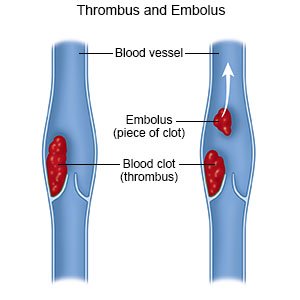 |
How to prepare for a mechanical thrombectomy:
- Your surgeon will talk to you about how to prepare for your procedure. You may be told to not to eat or drink anything after midnight on the day of your procedure. Your surgeon will tell you what medicines to take or not take on the day of your procedure.
- Contrast liquid may be used to help the clot show up better in x-ray pictures. Tell the healthcare provider if you have ever had an allergic reaction to contrast liquid.
- Arrange to have someone drive you home after your procedure. You may need to stay in the hospital for several days.
What will happen during the procedure:
The type of anesthesia you get will depend on where the procedure will happen. For a leg or collarbone procedure, you may be given local or spinal anesthesia to numb the area. You will not feel pain, but you may feel pressure. For a brain procedure, you may be given conscious sedation. General anesthesia may be used for any type of thrombectomy to keep you asleep and free from pain. Your surgeon will use an x-ray to find the blood clot.
- For a leg blood vessel, your surgeon will make an incision in your leg. The incision will be higher up your leg than the blood clot. Your surgeon will make an incision into an artery and insert a catheter (thin tube). An artery in the groin or behind the knee is usually used. Your surgeon will guide the catheter to the clot. The catheter has a balloon on the tip. Your surgeon will inflate the balloon at the tip and then pull the catheter back. This will dislodge the clot so it can be removed.
- For a collarbone blood vessel, your surgeon will make an incision along your collarbone. Your surgeon will open the artery and remove the clot. You may be given blood thinning medicine before and after the thrombectomy.
- For a brain blood vessel, your surgeon will place a catheter through your skin and into a blood vessel. The catheter will be guided up to the blockage. A device called a stent retriever may be used to remove the clot. The device is a wire mesh that closes around the clot so it can be pulled out of the blood vessel. Your surgeon may also inject medicines to dissolve a clot or treat a spasm in a blood vessel.
 |
What to expect after the procedure:
You may have swelling or pain in the procedure area. Your healthcare provider may give you medicines to reduce pain or swelling. You may be able to go home soon after your procedure. You may need to stay in the hospital for up to 1 week after an intracranial thrombectomy. Your provider may have you lie still for several hours right after your procedure. Your provider may then have you walk around to help prevent another blood clot.
Risks of mechanical thrombectomy:
The artery may be punctured or torn. You may have a heart attack if pieces of the blood clot break off during the procedure and travel to your heart or lungs. Other arteries may become blocked. You may have heavy bleeding and swelling when blood flow is restored. A thrombectomy in a brain artery can cause heavy bleeding into your brain.
Related medications
Medicines:
You may need any of the following:
- Medicines may be given to treat pain, high cholesterol, high blood pressure, or diabetes.
- Antiplatelets , such as aspirin, help prevent blood clots. Take your antiplatelet medicine exactly as directed. These medicines make it more likely for you to bleed or bruise. If you are told to take aspirin, do not take acetaminophen or ibuprofen instead.
- Blood thinners help prevent blood clots. Clots can cause strokes, heart attacks, and death. Many types of blood thinners are available. Your healthcare provider will give you specific instructions for the type you are given. The following are general safety guidelines to follow while you are taking a blood thinner:
- Watch for bleeding and bruising. Watch for bleeding from your gums or nose. Watch for blood in your urine and bowel movements. Use a soft washcloth on your skin, and a soft toothbrush to brush your teeth. This can keep your skin and gums from bleeding. If you shave, use an electric shaver. Do not play contact sports.
- Tell your dentist and other healthcare providers that you take a blood thinner. Wear a bracelet or necklace that says you take this medicine.
- Do not start or stop any other medicines or supplements unless your healthcare provider tells you to. Many medicines and supplements cannot be used with blood thinners.
- Take your blood thinner exactly as prescribed by your healthcare provider. Do not skip a dose or take less than prescribed. Tell your provider right away if you forget to take your blood thinner, or if you take too much.
- Take your medicine as directed. Contact your healthcare provider if you think your medicine is not helping or if you have side effects. Tell your provider if you are allergic to any medicine. Keep a list of the medicines, vitamins, and herbs you take. Include the amounts, and when and why you take them. Bring the list or the pill bottles to follow-up visits. Carry your medicine list with you in case of an emergency.
Slowly return to your normal activities:
Walk around often and return to your activities as directed by your healthcare provider. Avoid strenuous activity for 3 weeks. Do not drive until your provider says it is okay. You may need to wait a week or longer before you can start driving again.
Care for the incision area:
- Keep the incision area clean and dry. Ask your healthcare provider when you can bathe. You will need to keep the bandage in place and dry for a day or two after your procedure. Cover the bandage with a plastic bag and tape the opening around your skin to keep water out. When you are allowed to bathe without a bandage, carefully wash the area with soap and water. Check the area daily for signs of infection, such as redness, swelling, or pus. Dry the area and put on new, clean bandages as directed. Change your bandage if it gets wet or dirty.
- Watch for bleeding and bruising. It is normal to have a bruise and soreness where the catheter went in. Contact your healthcare provider if your bruise gets larger. If the incision area bleeds, use your hand to put pressure on the bandage. If you do not have a bandage, use a clean cloth to put pressure over and just above the puncture site. Seek care immediately if the bleeding does not stop within 10 minutes.
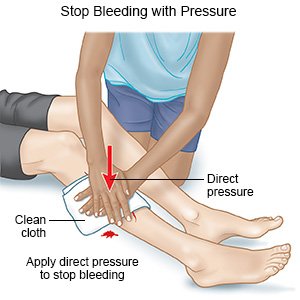
- Apply ice to the incision area as directed. Ice can help reduce pain, swelling, and bruising. Use an ice pack, or put crushed ice in a plastic bag. Cover the ice pack or bag with a towel and apply it to the area for 20 minutes every hour, or as directed.
Wear a compression device as directed:
Examples include pressure stockings, intermittent pneumatic compression, and sequential compression devices. A compression device puts pressure on your lower legs to help keep blood from pooling in your leg veins. Your healthcare provider can prescribe the right device for you. Do not buy over-the-counter devices unless your provider says it is okay. They may not fit correctly or may have elastic that cuts off your circulation. Ask your provider when to start wearing a compression device and how long to wear it.
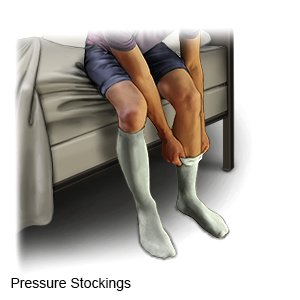 |
Prevent another blood clot:
- Keep your legs elevated as directed. Keep your legs above the level of your heart when you are sitting. Prop your legs on pillows to keep them elevated comfortably. Ask how long to keep your legs elevated each day. You will need to balance elevation with movement to prevent blood clots.
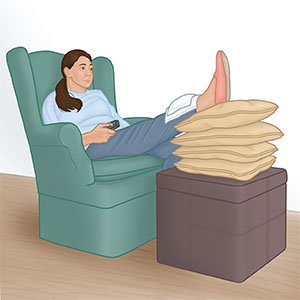
- Stay active. Your healthcare provider will tell you when it is safe to start doing your normal daily activities. Go slowly at first. Then increase your activity. An active lifestyle can help prevent blood clots. Try to get at least 30 minutes of activity on most days of the week. If you sit most of the day for work, stand or walk around every half hour. After a future injury or illness, try to become active again as soon as possible. Activity can also help you manage your weight. Extra body weight can put pressure on your leg veins and cause blood to pool. This increases your risk for another blood clot.
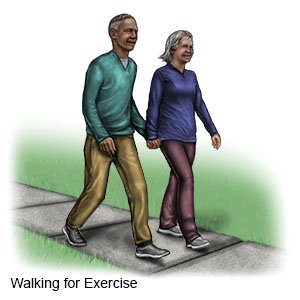
- Do not smoke. Nicotine and other chemicals in cigarettes and cigars can cause blood vessel and lung damage. Ask your healthcare provider for information if you currently smoke and need help to quit. E-cigarettes or smokeless tobacco still contain nicotine. Talk to your provider before you use these products.
- Limit alcohol. Do not drink alcohol for 24 hours after your procedure. Then limit alcohol. Limit alcohol to 1 drink a day if you are female. Limit alcohol to 2 drinks a day if you are male. A drink is 12 ounces of beer, 5 ounces of wine, or 1½ ounces of liquor.
- Manage other health conditions. Follow your healthcare provider's directions to manage health conditions that can cause a blood clot. Examples are high cholesterol and diabetes.
- Drink liquids as directed. Liquid can help prevent blood clots. Ask your healthcare provider how much liquid to drink each day and which liquids are best for you.
Follow up with your doctor or hematologist as directed:
You may need to come in for regular tests of your brain function. If you are taking warfarin, you will need to come in for regular blood tests. Your INR levels will also need to be checked. These tests help make sure you are taking the right amount of warfarin. You may need to be checked for blood clots for up to 3 years after treatment. Write down your questions so you remember to ask them during your visits.
© Copyright Merative 2025 Information is for End User's use only and may not be sold, redistributed or otherwise used for commercial purposes.
The above information is an educational aid only. It is not intended as medical advice for individual conditions or treatments. Talk to your doctor, nurse or pharmacist before following any medical regimen to see if it is safe and effective for you.
Further information
Always consult your healthcare provider to ensure the information displayed on this page applies to your personal circumstances.
